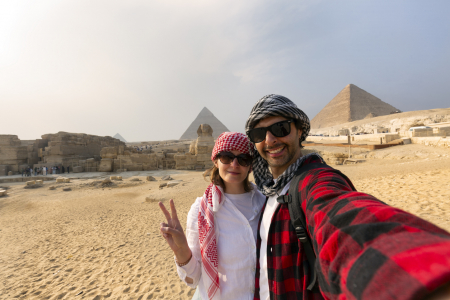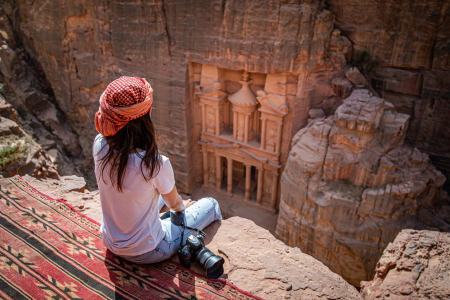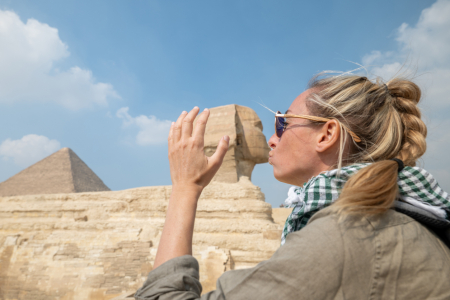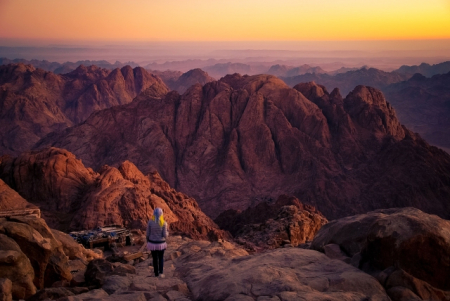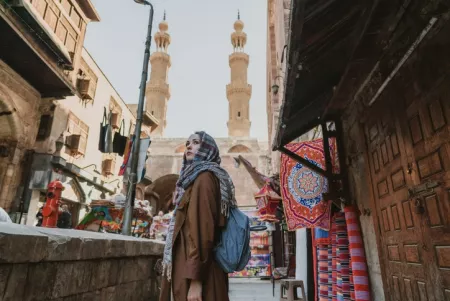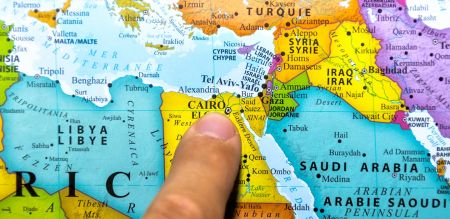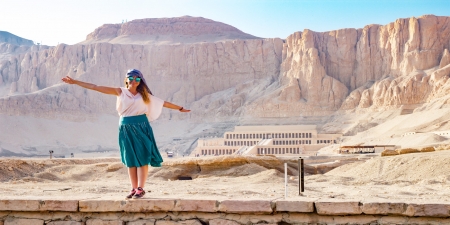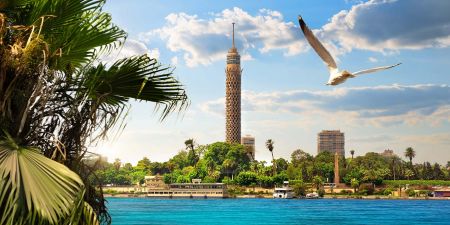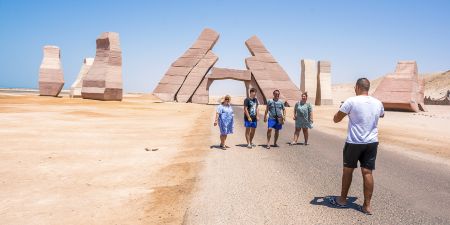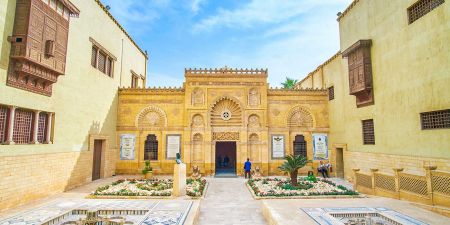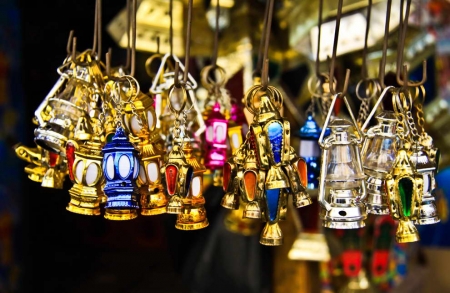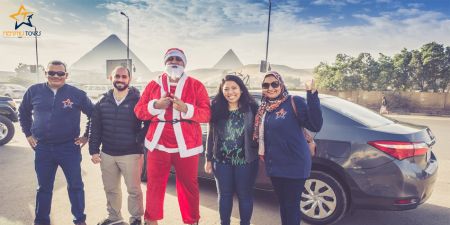Trail of the Holy Family in Egypt
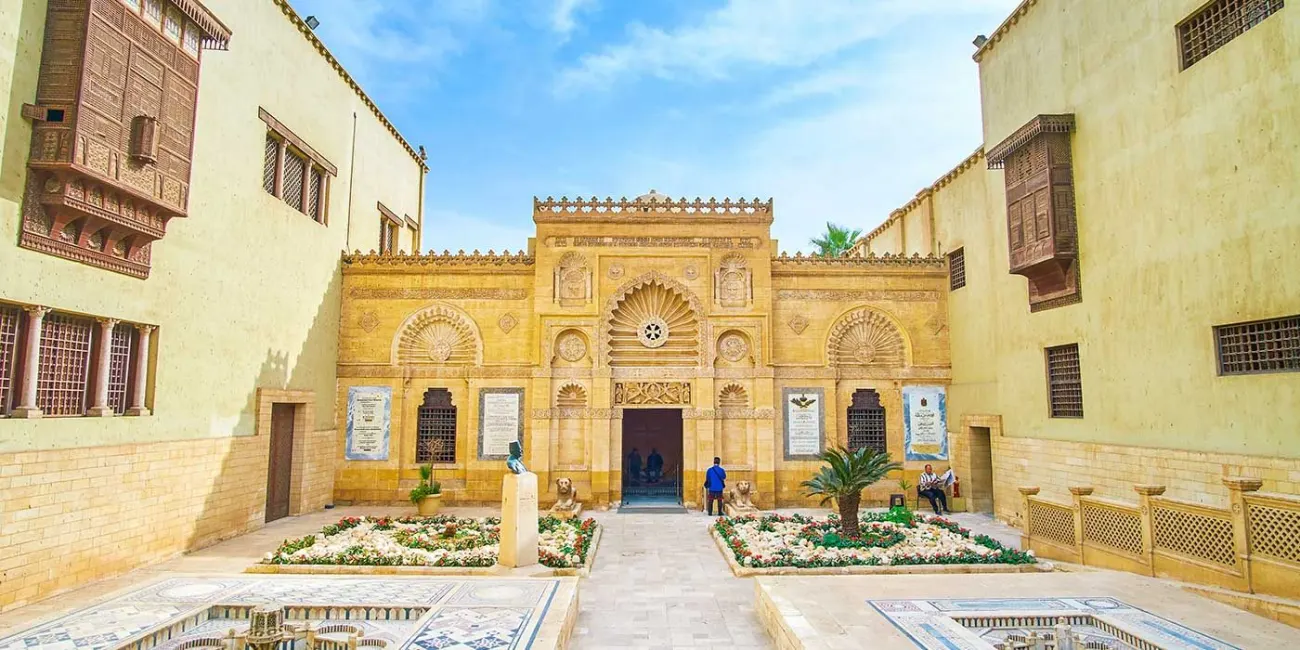
The journey of the Holy Family in Egypt is of great importance to the Coptic Church and it is a common practice for church groups or specialized travel agencies, especially during Christmas time, to arrange tours to follow along the exact path that the Holy Family is said to have taken.
According to the sources of the Coptic Orthodox Church, chief among which is the vision documented by Pope Theophilus and recorded in the Coptic Synexarium, the Holy Family proceeded from Bethlehem to Gaza, and from there to El Zaraniq (also known as Floussiat), some 37 km west of El Arish; then they threaded their way along northern Sinai until they reached Farma (ancient Pelusium) mid-way between El Arish and present-day Port-Said.
The Holy Family at Basta
Tel Basta is a short distance from Zagazig, the main town in the Sharqiah Governorate about 81 km northeast of Cairo. Here, Jesus caused a water spring to well up from the ground.
The Holy Family in the town of Mostorod
In due course, they reached Mostorod (which came to be called in those days, Al Mahama), only about 10 km away from Cairo. Al Mahama means “the Bathing place,” a name given to the town because the Virgin Mary bathed the Christ Child there and washed His clothes. It is worth noting that, eventually, on their way back to Palestine, the Holy Family stopped once more at Mostorod and caused a spring to gush from the earth, which still flows to the present day.
The Holy Family at the Town of Belbeis.
From Mostorod, the Holy Family made their way northeastwards to Belbeis (ancient Philippos), back in Sharqiah Governorate, and at a distance of about 55 km from Cairo. They rested there in the shade of a tree, which came to be called, “The Virgin Mary’s Tree.”
The Church of St. John
Having left their mark on Belbeis, the Holy Family continued the journey to the north and passed by the town which is currently known as Zagazig.
The Holy Family at Meniet Sammanoud
Then they made their way to Meniet Sammanoud (known also as Meniet Genah) and passed by the town known as Daqadous, where a church of the Virgin Mary is found. There is also a water well from which the Holy Family drank. Then they crossed the Nile to the city of Sammanoud (or Enmity) in the Delta, where the local population received them with kindness and hospitality. There, to this day, a large granite trough which, according to local belief, was used by the virgin for kneading dough, and a water well which the Christ Child Himself blessed.
Again towards the northwest, the Holy Family traveled to the city of Sakha, in the lake district of Burullus, in the present-day governorate of Kafr El-Sheikh.
The Holy Family at Sakha Town
The Coptic name of the town, “PekhaIssous” means the “Foot of Jesus” for the Holy Child’s footprint was marked here, in bas-relief on a rock. The rock was preserved, but hidden for centuries for fear of robbery, and was only unearthed on 27 September 1984.
The annual course of the Holy Family’s journey from Sammanoud to Sakha would have taken them through many of the towns and cities now lying in both the Governorates of Gharbia and Kafr El–Sheikh and, according to some folk traditions, through the Belqas wastelands.
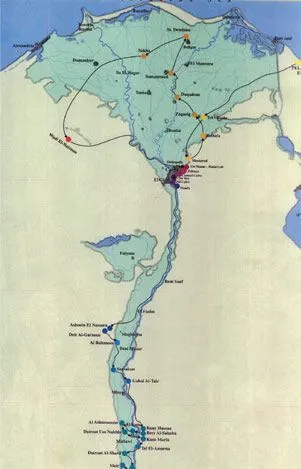
The Holy Family at Wadi El-Natroun
St. Bishoy - Wadi NatrounTheir trail from Sakha, is recorded in the documentation of Pope Theophilus vision and attested to by Coptic practice in the Christian era. They came to Wadi El Natroun (Natroun Valley) after crossing the Rosetta branch of the Nile to the Western Delta and headed south into Wadi El Natroun (Scetis) in the Western Desert of Egypt. Before reaching there, the Holy Family passed by the spring of Al Humra, where the Infant Jesus caused a water spring to well up from the ground and the well is called Beer Mariam (Mary’s Well) to this day. In the earliest decades of Christianity, the desert expanses of Wadi El Natroun became the site of monastic settlements and later, of many monasteries, in spiritual commemoration of the Holy Family’s passage through the valley.
The Holy Family at Matariya and Ain Shams
Virgin Mary's tree in MatariyaEventually, they left the desert behind them and made their way southwards, crossing the Nile to the eastern bank, heading to Matariya and Ain Shams (ancient Heliopolis). Both these adjacent districts are outlying suburbs of present-day Cairo, only 10 km or so from the city center.
At the time of the Holy Family’s arrival there, Ain Shams was home to a large Jewish community, that have erected a temple – the Synagogue of Unias, – for their worship. In Matariya, a tree still stands to this day and is still regularly visited. Called the “Mary’s Tree,” it is believed that the Family rested in its shade. Here, too, the Infant Jesus caused water to flow from a spring, from which He drank and blessed, and in which the Virgin Mary washed His clothes. She poured the washing water on the ground, and from that spot, the fragrant balsam plant blossomed. Besides the healing and pain-soothing properties of this balm, its essence is used in the preparation of scents and perfumes of which the holy Chrism is composed.
The Holy Family at Zeitoun
Setting out next towards Old Cairo, the Holy Family rested for a while in Zeitoun, then proceeded along a course that traverses what is now crowded, bustling quarters of Cairo, within which the scene landmarks of an earlier Coptic heritage still stand, marking the paths the Holy Family followed. A listing of these landmarks, at this point, may be of pertinent interest.
The Holy Family in Old Cairo
The area now called Old Cairo, known as Misr el Kadima, is among the most important locations visited by the Holy Family where the spiritual impact of their presence is still most felt, though their stay was brief. The Governor of what was then Fustat became enraged by the tumbling of idols at Jesus’s approach and sought to kill the Child. They took shelter from his wrath in a cave above which, in later years, the Church of Abu Serga (St. Sergius) was built. This, and the whole area of the Fort of Babylon, is a destination of pilgrimage not only for Egyptians but for Christians from around the world.
The Holy Family at Maadi
Maadi ChurchAfter the short stay in Old Cairo, the Holy Family moved in a southerly direction, reaching the modern suburb of Maadi, which in earliest Pharaonic times, was an outlying district of Memphis, the capital of Egypt then. At Maadi, they boarded a sailing boat that carried them up the Nile towards southern Egypt. The historic church built upon the spot from which they embarked, also dedicated to the virgin, is further identified by the denominative, “Al Adaweya,” the Virgin’s Church “of the Ferry.” In fact, the name of that now modern suburb, Maadi, derives from the Arabic word which means “the crossing time.”
The stone steps leading down to the River’s bank, and believed to have been used by the Holy Family are accessible to pilgrims through the Church courtyard.
An event of miraculous importance occurred on Friday the 3rd of the Coptic month of Baramhat, the 12 of March, 1976. A Bible floated along the ripples of the Nile to the bank below the Church. It was open to the verse of Isaiah (19:25) that declares: “Blessed be Egypt My People.” The Bible is now behind glass in the Sanctuary of the virgin in the Church for all to see.
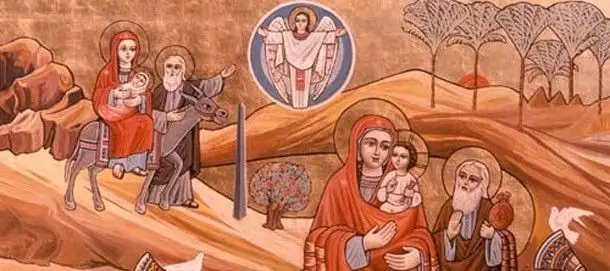
The Holy Family at Deir El Garnous Maghagha
The sail-boat docked at the village of Ashnein El Nassara, then the village of Deir el Garnous, (the later site of the Monastery of Arganos) 10 km west of Ashnein El Nassara (a small village near the town of Maghagha). Outside the western wall of the church of the Virgin there, a deep well is believed to have provided the Holy Family with the water they needed.
The Holy Family at Al Bahnassa
They went on from there to a spot later named Abai Issous, “the Home of Jesus,” the site of present-day Sandafa village, east of Al Bahnassa which, stands some 17 km west of the town of Beni Mazar.
Gabal Al Tair Samalout
On towards the south they went from Bahnassa to Samalout, crossing the Nile again to the spot on the east bank of the River where the Monastery of the Virgin now stands upon Gabal al Tair east of Samalout. It is known by this name (Gabal Al Tair) because thousands of birds gather there. The Holy Family rested in the cave which is now located inside the ancient Church there.
Coptic tradition maintains that, as the Holy Family rested in the shade of the Mountain, Jesus stretched His little Hand to hold back a rock that was about to detach itself from the mountainside and fall upon them, the imprint of His palm is still visible. When they resumed their travels, the Holy Family passed a laurel tree a stone’s throw south of Gabal El Tair, along the pathway flanking the Nile and leading from the Mountain to Nazlet-ebeid and the new Minia Bridge of today. It is claimed that the tree bowed to worship Jesus as He was passing, and the configuration of the Tree is, indeed, unique: all its branches incline downwards, trailing on the ground, and then turn upwards again, covered in a cloak of green leaves. They call the Tree: “al abed” or “the Worshipper.”
The Holy Family in the town of Al Ashmounein
The Holy Family left Gabal El Teir and traveled southwards and passed by Beni-Hassan continuing still to the town of Al Ashmounein or Hermopolis Magna.
Leaving behind them the rubble of the fallen idols, they blessed Al Ashmounein and made their way to the south till they reached Dairout Um Nakhla where Jesus also caused a spring of water to flow. From Tel Amarna, the Holy Family sailed across the Nile again and made their way 10 km towards the south and then to Qussqam (or Qost-Qoussia). Here too, the recorded events testify that the townsfolk were infuriated when the stone statue of their local deity cracked and fell, and evicted the Holy Family from the town. A historically recorded incident dating to that period refers to the devastation of Qussqam, and Coptic tradition asserts that the ruin that befell the town was the consequence of its violent rejection of the gentle visitors.
Customize Your Dream Vacation!
Get in touch with our local experts for an unforgettable journey.
Plan Your TripThe Holy Family at Mount Qussqam
Now it was time for the Holy Family to set out for what is, arguably, the most meaningful destination of all in the land of Egypt, the place where there would be “an altar to the Lord in the midst of the land of Egypt” Gabal (mount) Qussqam, which takes its name from the town nearby that was laid waste, is 327 km south of Cairo, and stand in the Governorate of Assiut, the Monastery of Al Muharraq nestles against the western foothills of the Mountain. It was built around the area where the Holy Family remained for just over six months. Their time was spent mainly in a cave which became, in the Coptic era, the altar of the Church of Virgin Mary, built at the western end of the monastery compound.
The altar stone was the resting place of the Child Jesus during the months He dwelt there. The whole area – the Monastery and its surroundings – is redolent of the Coptic Christian ethos. It was here, at the very spot where Al Muharraq Monastery stands, that the angel of the Lord appeared to Joseph in a dream and said: “Arise, and take the young Child and His mother, and go into the land of Israel; for they are dead which sought the young Child’s life.” (Mathew 2:20)
The Return Journey
And so they set forth on the return journey. The route they took deviated slightly from the one by which they had come. It took them to the Western Mountain, 8 km southwest of the city of Assiut, and their blessing of this location was commemorated in the Christian era by the building of the mountain-top Convent of the Virgin Mary.
Eventually, they arrived at Old Cairo, then Matariya, and on to Mahama, retracing more or less their steps on their outward journey across Sinai to Palestine.
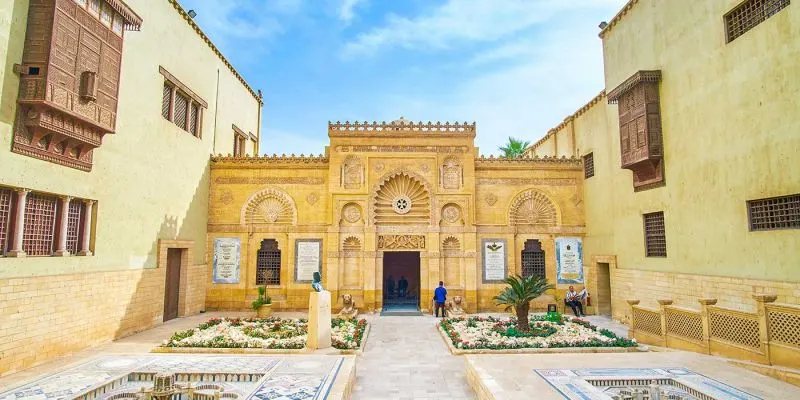
The Trail of the Holy Family in Egypt is a historic pilgrimage route that follows the journey of the Virgin Mary, Joseph, and the Christ Child during their flight into Egypt. The trail passes through sacred Christian sites such as Tel Basta, Mostorod, Sakha, Wadi El-Natroun, Old Cairo, Maadi, and the Monastery of Al Muharraq in Assiut, making it one of the most important religious and cultural routes in Egypt.
Some of the most important stops include Tel Basta (Zagazig), Mostorod near Cairo, the Virgin Mary’s Tree in Matariya, the churches of Old Cairo, Maadi Church, Sakha in Kafr El-Sheikh, Wadi El-Natroun monasteries, and the Monastery of Al Muharraq in Assiut. Each site has deep Coptic Christian heritage and is marked by miracles, holy wells, and churches.
Yes, tourists and pilgrims can visit the Holy Family sites across Egypt, many of which are open year-round. Popular destinations include the Church of St. Sergius (Abu Serga) in Old Cairo, Mary’s Tree in Matariya, Sakha Rock of Jesus’ footprint, and the Monastery of Al Muharraq in Assiut. Specialized travel agencies in Cairo, Alexandria, and Luxor also arrange guided Holy Family pilgrimage tours.
Following the entire Holy Family Trail can take between 7 to 12 days, depending on the itinerary. Most tours start in Cairo (Old Cairo, Maadi, Matariya), continue through the Delta (Zagazig, Sakha, Wadi El-Natroun), and then head south to Assiut where the Holy Family spent over six months at the Monastery of Al Muharraq.
The Trail of the Holy Family in Egypt is one of the most sacred Christian routes outside the Holy Land. It commemorates the time when the Holy Family lived in Egypt for over three years, leaving behind springs, sacred trees, ancient churches, and monasteries. For Christian pilgrims, visiting sites like Abu Serga Church in Old Cairo, Maadi Church on the Nile, and Al Muharraq Monastery in Assiut is a spiritual journey connecting faith, history, and Egypt’s Coptic heritage.

